
Steamboat Photos - Showboats
In this exhibit: the Cotton Blossom, French's New Sensation, Showboat Majestic, Edward's Moonlight, New Era Floating Palace,Showboat Hollywood, Showboat River Queen, Price's Floating Opera, Price's New Water Queen, Bryant's Showboat, and the Goldenrod.
Cotton Blossom
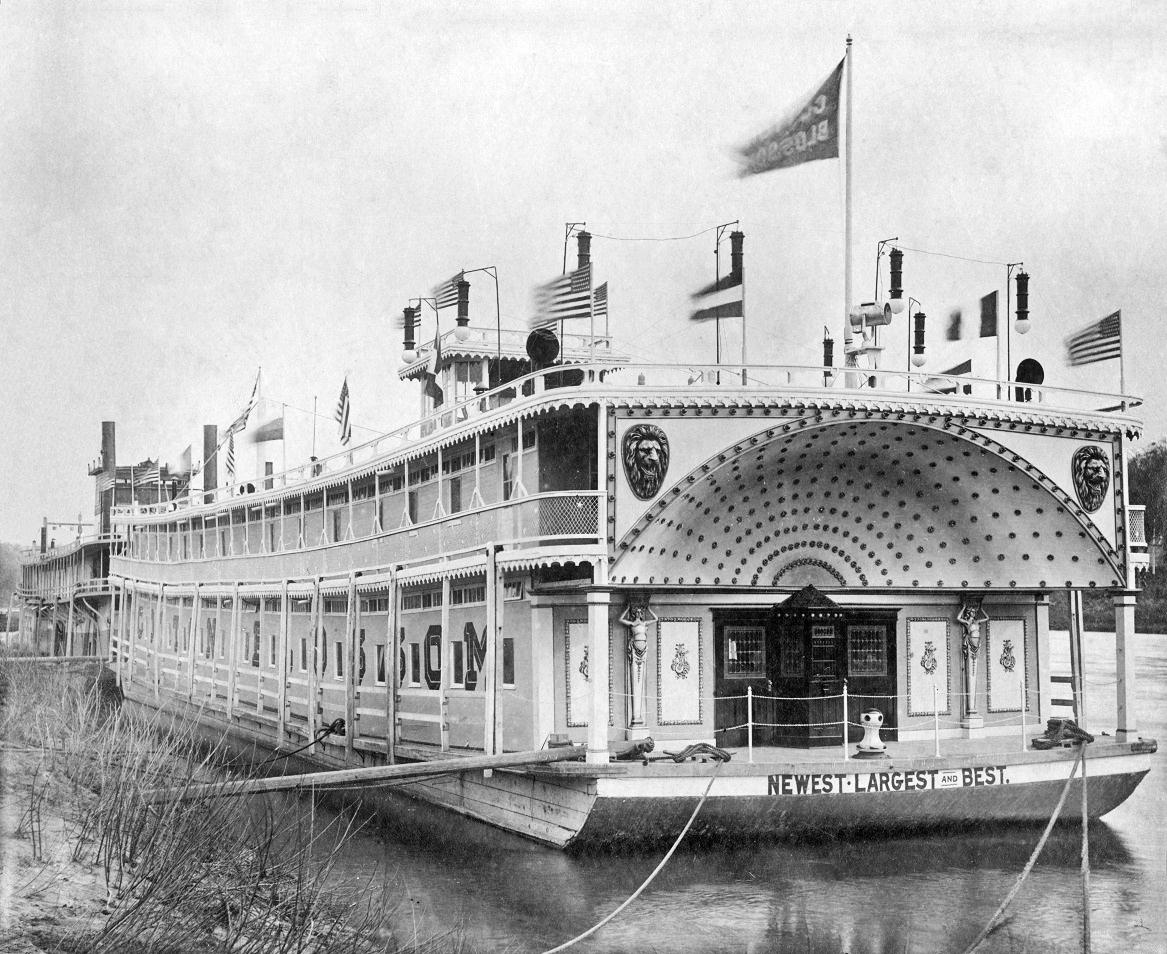
COTTON BLOSSOM Showboat Built in 1908
Formerly Eisenbath and Henderson's GREAT MODERN TEMPLE OF AMUSEMENT
Owners:
Steiner and Needham (1908)
R. W. Emerson (1909)
R. W. Emerson and Roy Hitner (1914)
Ran on the Mississippi and Ohio River
Seated 900 people. She could be identified by the "dishpan front" with lights.
The COTTON BLOSSOM was crushed by ice at Mount Vernon, Indiana along with the towboat JEWEL in 1918.
Some of the towboats which escorted the COTTON BLOSSOM during her career of the rivers:
The SOPHIA M. GARDNER in 1910 and 1914.
The JEWEL in 1916 and 1918.
The COTTON BLOSSOM was also transported during unspecified periods by the ECLIPSE, FURY, GRACE DEVERS, MARGARET HALL and WALTER NEEDHAM.
There must have been other unspecified towboats who pushed the COTTON BLOSSOM as well. Some letters on the pilot house name board of the towboat in this photo are visible but there are not enough letters displayed to determine the boat's name. This original photo measures 7.70 X 9.35 inches, a pricey eBay acquisition.
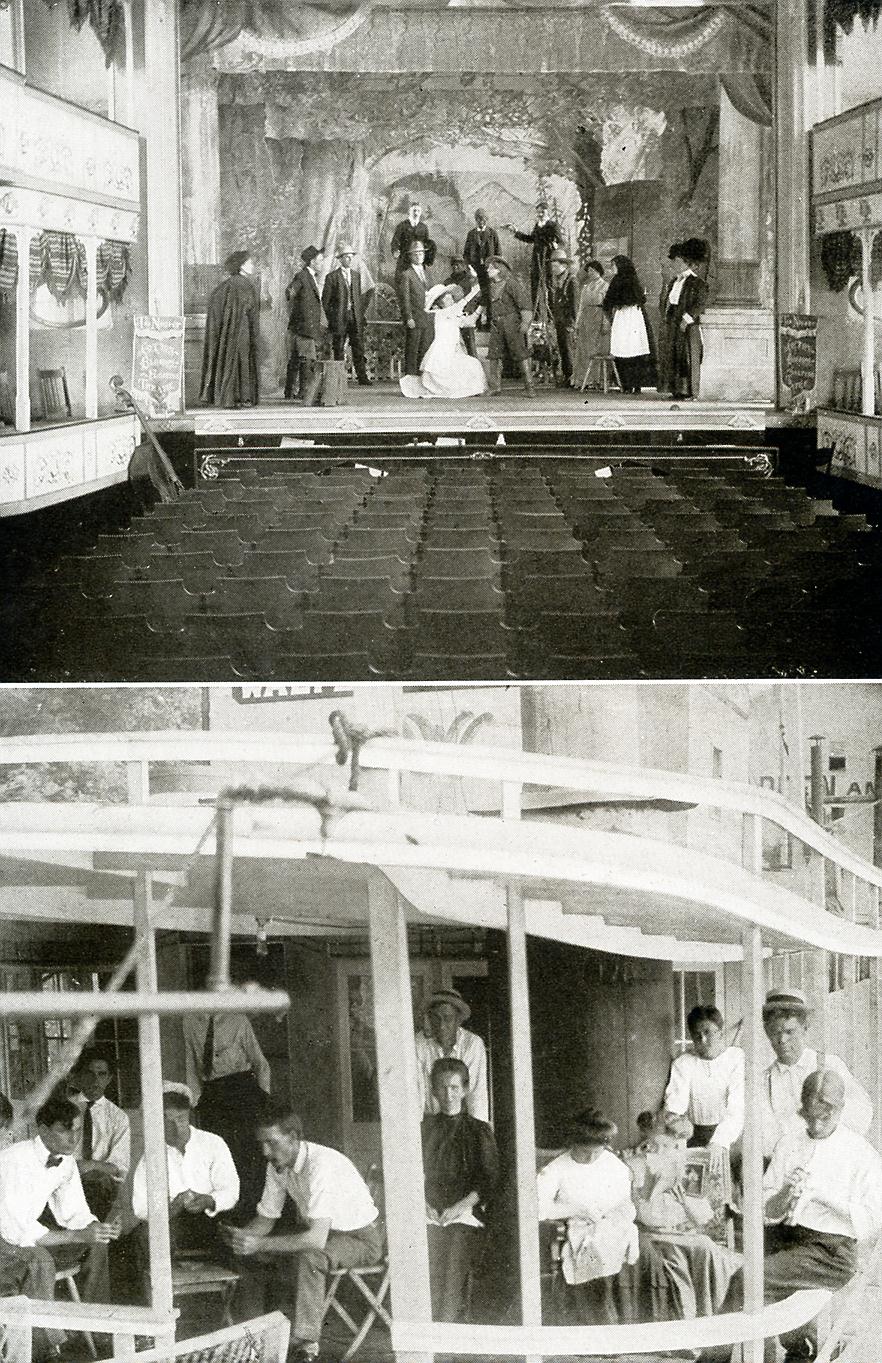
These 2 screened photos came from an unknown and undated "pictorial" magazine about the COTTON BLOSSOM showboat showing cast members rehearsing a play and playing cards on the towboat that pushed the floating theatre up and down the river which I believe was probably the WALTER NEEDHAM (from a few letters visible on the pilot house name board).
text of caption:
Top picture shows a dress rehearsal on the Cotton Blossom, Mississippi River floating theatre.
Bottom picture shows the floating theatre performers off-duty. Leisure hours find the upper forward deck of the steamer occupied by the actors seeking diversion."
Dreamland
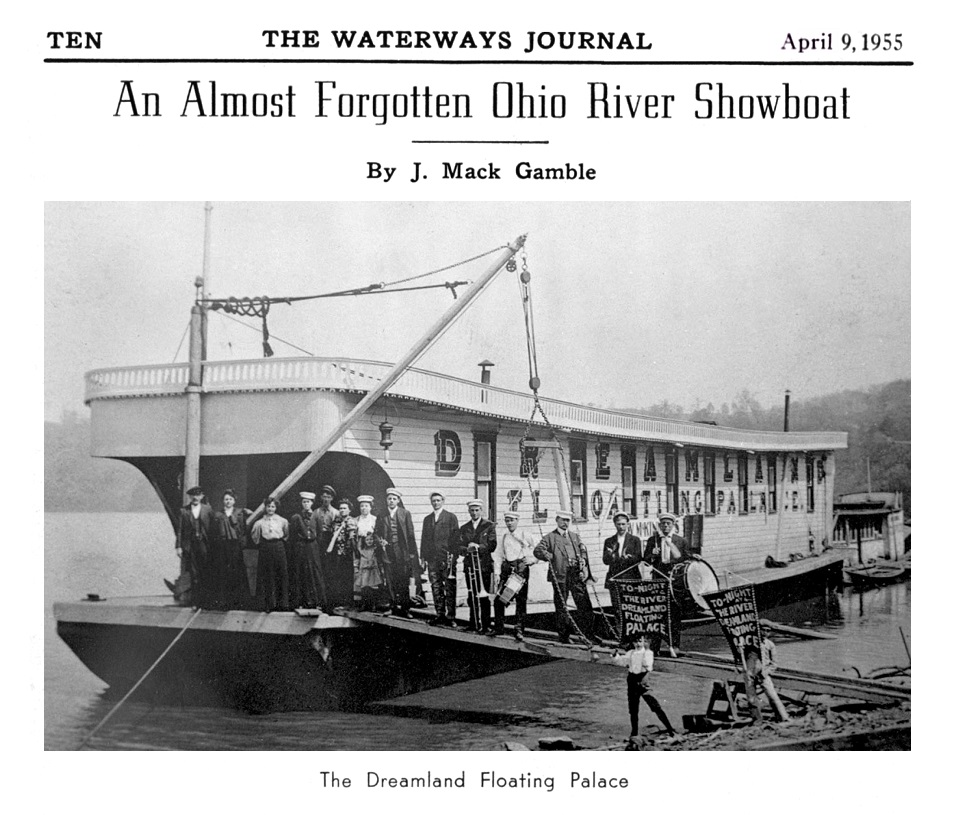
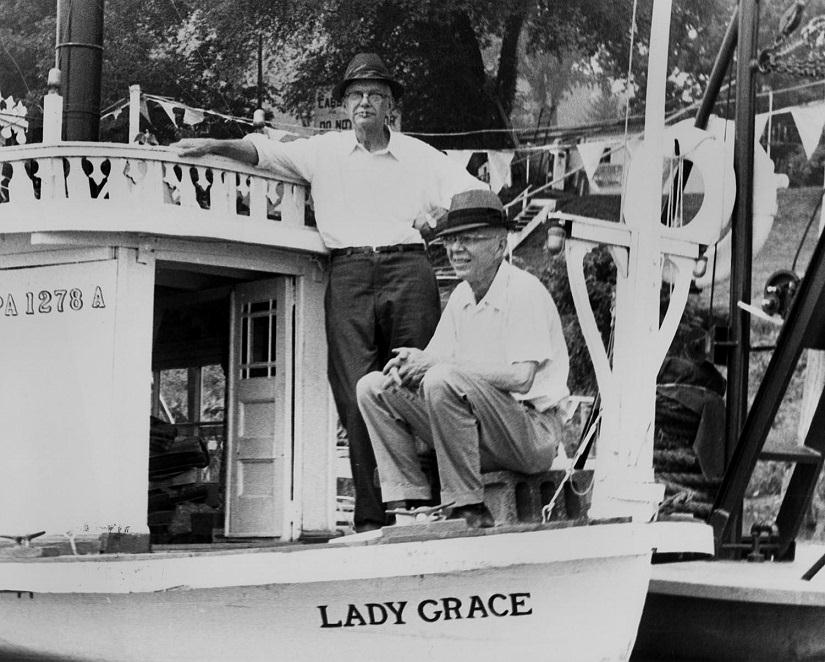
Waterways Journal 1955 An Almost Forgotten Ohio River Showboat, the DREAMLAND
J. Mack Gamble's article on the showboat DREAMLAND from the 1955 the bound WATERWAYS JOURNALS volume. The photograph has been upgraded by replacing the one in the weekly with the one in the La Crosse collection and the text scanned from the original article. A profile of Mr. Gamble is included after the conclusion of his article. The photo of Gamble standing behind Fred Way aboard Fred's sternwheel launch LADY GRACE is also from La Crosse.
An Almost Forgotten Ohio River Showboat
WATERWAYS JOURNAL
Page 10
April 9, 1955
By J. Mack Gamble
For a good many years the writer believed there was once an Ohio River showboat named the Dreamland, contemporary with the Wonderland and other famous floating theatres. Questioning of various showboat authorities brought the response that they seemed to have some vague remembrance of such a boat, but details were not to be learned.
The U S. List of Merchant Vessels, in the section on "Unrigged Vessels," listed a boat of that name, 61 tons, built in 1905 at McKeesport, Pa.
Finally The Waterways Journal, which can always be depended on to come up with some help, said in its Forty Years Ago column that, on March 14, 1914, the showboat Dreamland was wintering in the mouth of Kanawha River along with Reynold Brothers' new floating theatre and the Water Queen, Princess, Cotton Blossom, etc.
Inquiry from Capt. Thomas J. Reynolds, of Point Pleasant, W Va., owner of the Majestic, last surviving touring showboat, revealed that he did recall the Dreamland as a small showboat built somewhere in Pennsylvania. On a fairly recent visit of the Majestic at Fairmont, W Va., he had been visited by a lady who showed him a picture of the Dreamland. Thinking that a picture of the showboat would be clinching proof of the writer's contention that there was such a craft, it was determined to forward a letter to Mrs. Mary Long McMillen, of Fairmont. Mrs. McMillen responded most graciously and reported that she did indeed have one picture of the Dreamland, which had been presented to her by the owner of the boat some 50 years ago. As a girl Mrs. McMillen lived at Opekiska, W Va., where her parents, Mr. and Mrs. James C. Long, operated a store and a ferry. Her picture of the Dreamland was made at Point Marion, Pa., and shows not only the boat but also the crew and the dramatic company aboard. Mrs. McMillen kindly offered to have a copy negative made of her picture, and this made possible the presentation, in company with this story, of the only known picture of the Showboat Dreamland.
Information indicated that a son of the owner of the Dreamland was still living somewhere around Elizabeth, Pa. The aid of Steve Mackinack, builder of model steamboats and river enthusiast extraordinary, was then secured and he succeeded in putting the writer in touch with Harry E. McKinney of West Elizabeth. Mr. McKinney reported that his father, Capt. A. W McKinney, built the Dreamland at McKeesport in 1905, that the boat was 100 feet long by 20 feet in width, and had a seating capacity of approximately 300 people. The new boat made its first tour in 1906 carrying a vaudeville and musical comedy show as well as moving pictures.
The Dreamland was operated along the Monongahela and as far down the Ohio River as Louisville, Ky. It was first towed by a gas boat named the Clarion and Mr. McKinney did not know where his father built this boat. However, government records say that the first Clarion was built at Pittsburgh in 1895, had 20 hp., and was 45 by 10 feet in hull size. This boat was dismantled at Henderson, W Va., in 1914 when Capt. McKinney built the Clarion No. 2 which was 65 by 14 feet in size. Capt. A. W McKinney died in 1916, and Harry McKinney sold the Dreamland to two men in Pittsburgh who used it for a club boat. It is believed the craft was later carried away in an ice gorge and destroyed. The Clarion No. 2 was also sold and has since been dismantled.
ABOUT J. MACK GAMBLE:
riverhistory.org
Mr. J. Mack Gamble was the first president of the Sons and Daughters of Pioneer Rivermen. His father was an owner of packet boats operating in the Upper Ohio River trades in the late 19th and the first decade of the 20th century.
For many years, he was also the chairman of the Board of Governors of S&D and was a leader in promotion of its aims and projects. J. Mack Gamble had worked for a brief period as a packet boat clerk before attending college but his life's work was as an educator. He held a master's degree in education and history from Ohio University in Athens and, after teaching at several one-room country schools in Monroe County, Ohio, was long the principal of the Clarington (Ohio) Elementary School.
Upon his death in 1973, J. Mack Gamble gave a sizeable bequest to the Sons and Daughters of Pioneer Rivermen. This bequest was used to establish the J. Mack Gamble Fund in 1976. The Fund is administered for the Board of Governors by three trustees.
French's New Sensation
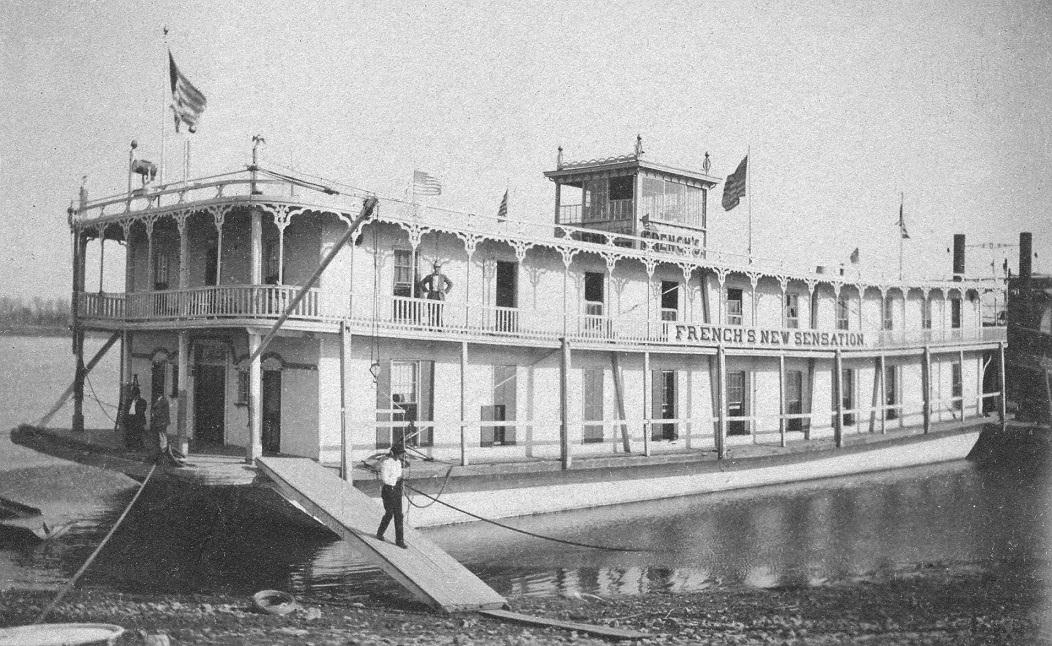
New Sensation
(Showboat, 1901-1931)
Built in 1901 at Higginsport, Ohio
Owned by A.B. French and John McNair (1901-1907), it was the last of the French's New Sensation showboats.
Seated 960. Operated by Callie French and John McNair until 1907 when it was sold to E.A. Price.
Last owned by J.W. Menke from 1918 to 1931
Toured the Mississippi and Ohio rivers
Towed by the CHAPERON and in 1916 by the CHAS. B. PEARCE
She was at Higginsport, Ohio in 1901 and at Madison, Indiana in 1926
Disabled by a storm at Mound City, Illinois in 1930; dismantled in 1931.
Wikipedia
The photo above comes from a cyanotype (blue "proof print") postcard. To learn more about Cyanotype postcards, visit the photo postcards page - click here.
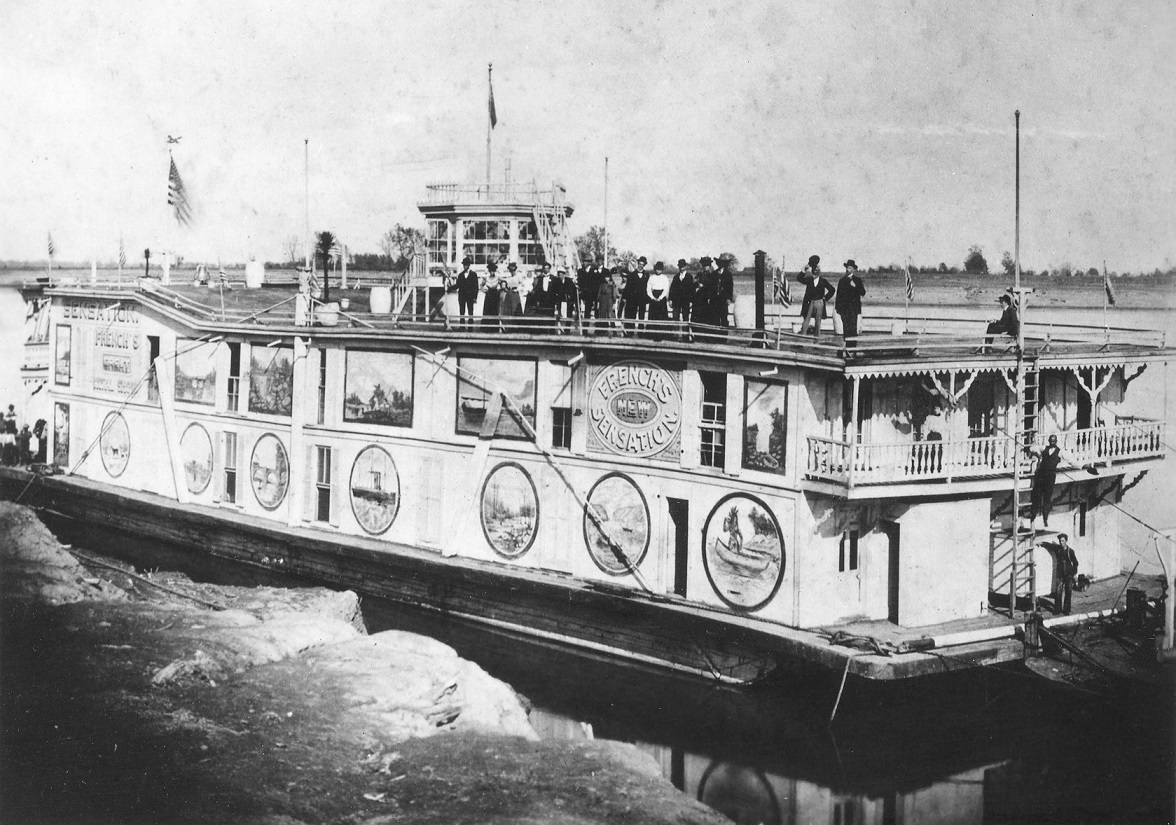
Remarkable image of the Showboat "French's New Sensation."
The paintings on the outside must've been in full color, gives it a carnival side show feel and I expect a Wurlitzer band organ to be playing and carousel horses riding in a circle on the top deck. The actors and crew are colorful characters, great slice of life in them days.
French's New Sensation was a theatre on a barge pushed by a towboat although apparently it could be steered from the whimsical looking pilot house on top of the floating theatre. Not sure how they hooked up the steering to the rudder or rudders of the towboat or how they communicated with the engine room to order full speed ahead, stop etc.
You can see a little bit of the front end of the towboat which pushed it. There are two towing knees pressed against the stern of the showboat and the tow is lashed to the barge upon which the theatre was built. You can also see part of the jackstaff (for want of a better name) on the front of the towboat.
Showboat Majestic
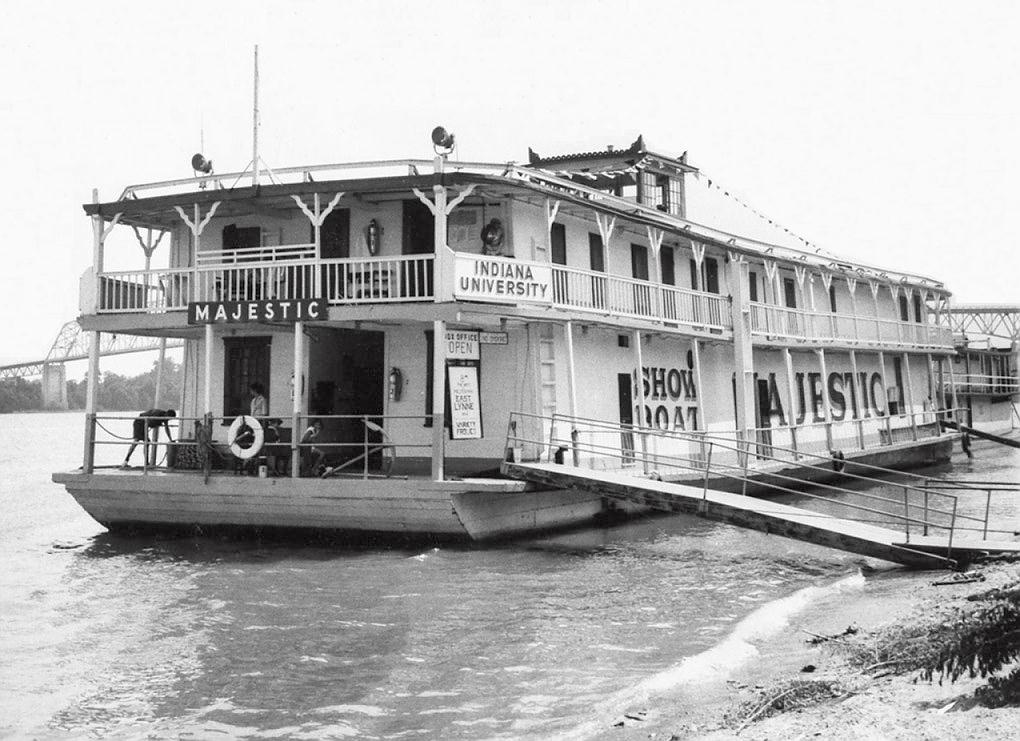
Associated Press Photo From Chicago 8-12-63
EDITORS: SUGGESTED FOR USE WITH SEYMOUR STORY IN AFTERNOON PAPERS OF TUESDAY, AUGUST 13.
Headline:
H E R E C O M E S T H E S H O W BO A T
"The showboat Majestic is moored at Rosiclare, Illinois on the Ohio River as part of an itinerary devoted not to travel but to summer stock presented by 14 students of Indiana University. A towboat powers it from one mooring to another."
From "Showboat MAJESTIC Since 1923" website:cincinnatilandmarkproductions.com
In 1923, Tom Reynolds' new Showboat Majestic slid into the water near Pittsburgh. This started the Majestic on a career that carried her over the Ohio River and it's tributaries for the next 20 years. The Reynolds family lived, played and performed on the "Boat" until World War II, when it was tied up at Henderson, West Virginia for three long years.
In 1945, Hiram College and Kent State University leased the Majestic from the Reynolds family as a summer theatre experience for students. This academic alliance revived the concept of Showboatin' and tramped the "Inland Waterway" once again. In 1960, Indiana University took over and maintained the tradition.
The "Safety at Sea Act" of 1965 finally prohibited the wooden-hulled Majestic from transporting its company town to town. It was tied up and dry-docked, this time in Jeffersonville, Indiana.
The City of Cincinnati purchased the Showboat Majestic in 1967 to serve as a focal point for the developing Central Riverfront. Until 1988, it was leased to the University of Cincinnati as a summer stock theatre for its students. Now, under the administration of Cincinnati Landmark Productions, in cooperation with the Cincinnati Recreation Commission, the Majestic is a professional summer stock theatre utilizing local performers, providing them opportunity and experience in a theatre rich with history, nostalgia and river romance!
While there are newer boats on the Ohio today, the Majestic was the last of the purpose-built "floating operas", the last to make one-night stands, the last to actively travel, the longest-lived under one owner and home of the largest family - the eleven Reynolds children - ever reared on a showboat.
With the burning of the original Goldenrod Showboat in St. Louis, MO., on June 1, 1962, the Showboat Majestic became the last survivor of the singularly American tradition of floating theatres. On December 20th 1989, the Showboat Majestic became an official National Historical Landmark (#89002456).
Edward's Moonlight
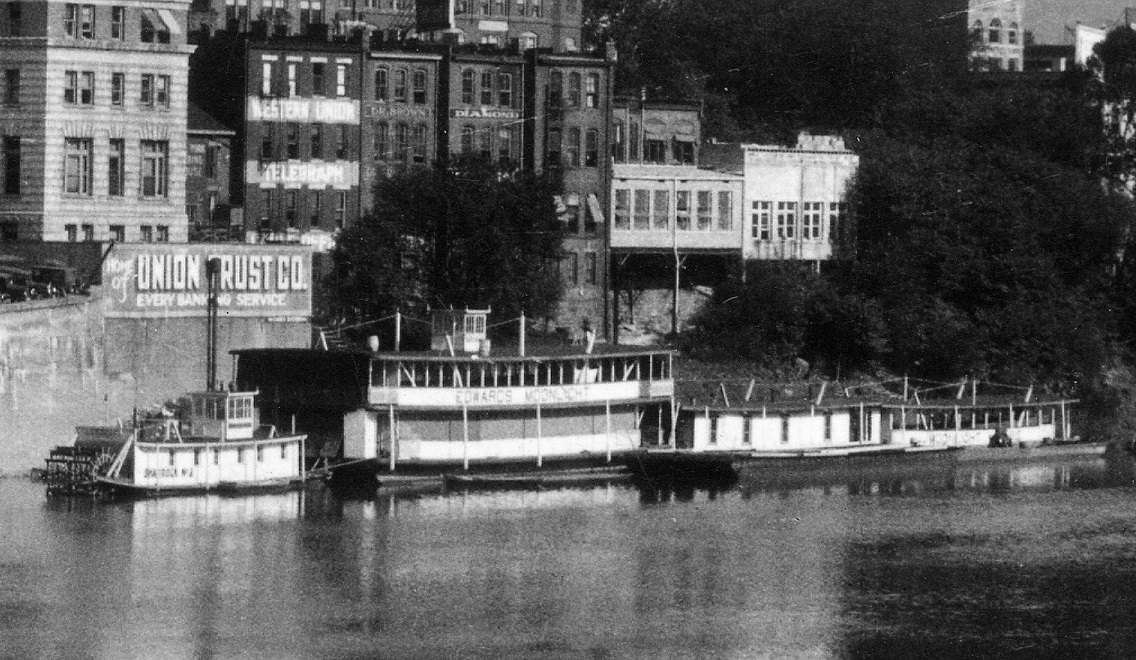
For a grainy old snapshot there was a lot of detail was revealed in a super hi rez scan of the image and I was able to I.D. the Shamrock and Moonlight from this and provided the attached scan and my observations to the Daily Mail during my correspondence with them. Charleston with Towboat Shamrock No. 2, Edwards, moonlight.
New Era Floating Palace
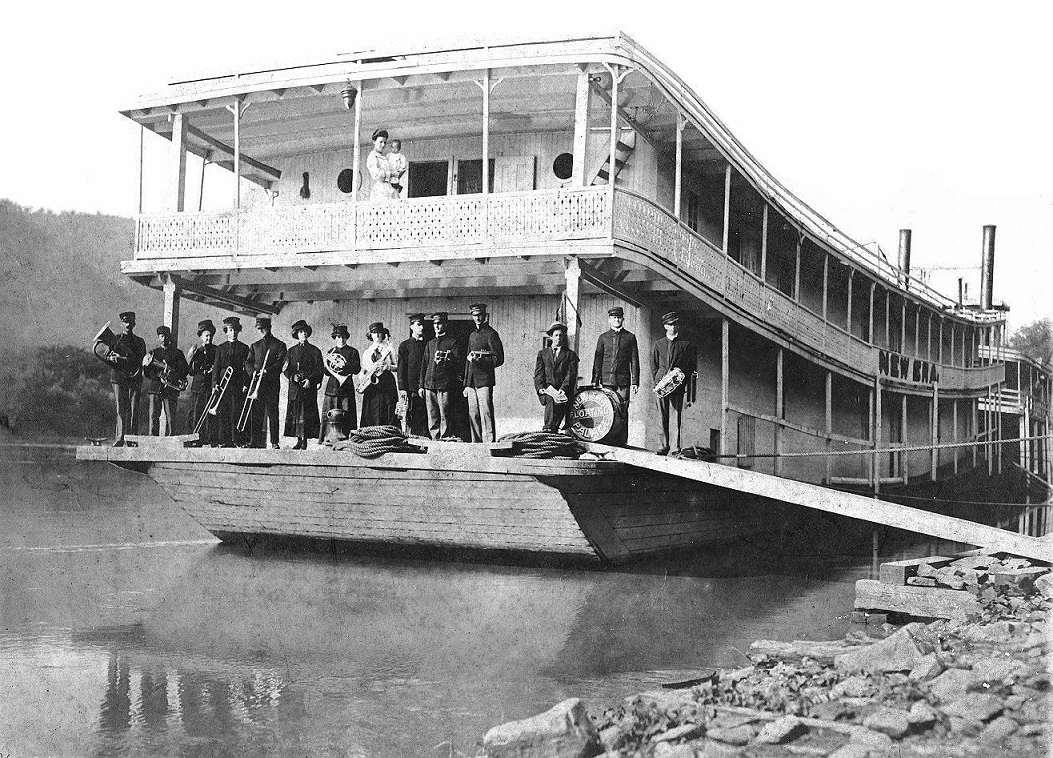
Attached old photo from eBay of the New Era Floating Palace and their co-ed band. Probably the musicians were mostly actors and stage hands when they weren't in uniform like this. The photo had some major goobers on it on the upper left top deck that took many man-hours to resolve. I had to guess what some parts looked like under the blemishes.
Showboat Hollywood
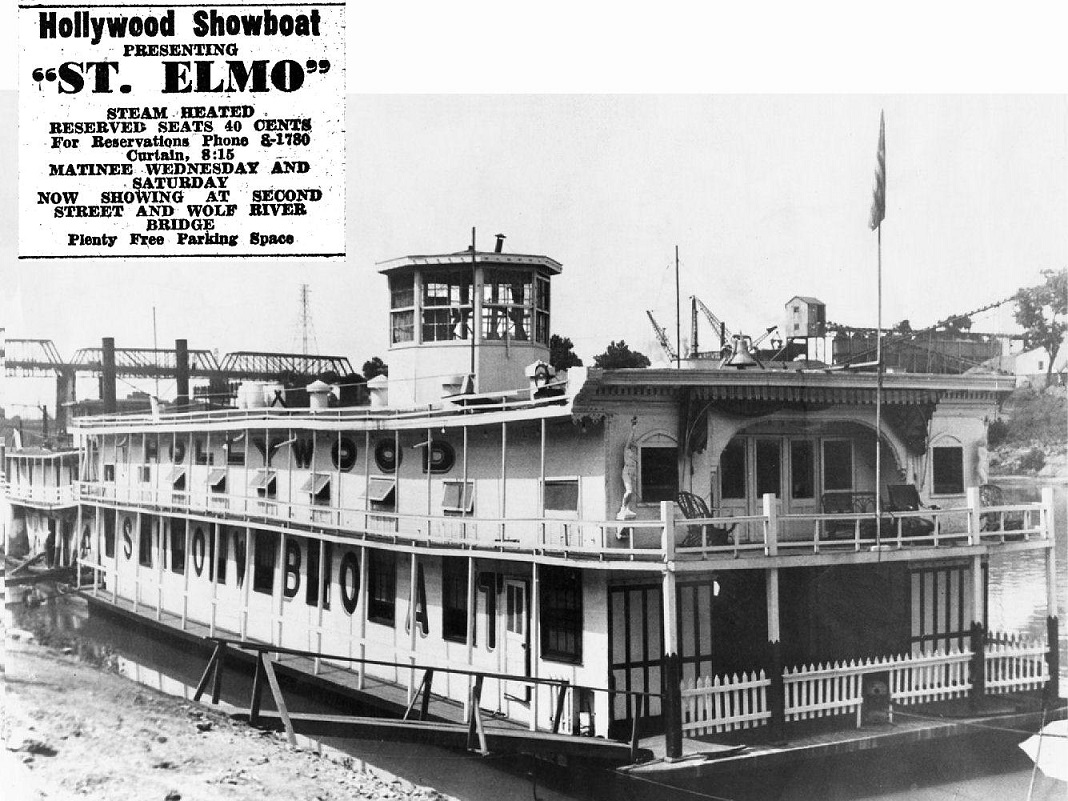
Dave says: I FOUND MENTION OF THE "HOLLYWOOD" IN VANCE LAUDERDALE'S "ASK VANCE" BLOG AND INCLUDE HIS POSTING BELOW AND THE AD FROM A NOVEMBER 1933 EDITION OF THE MEMPHIS COMMERCIAL APPEAL NEWSPAPER THAT LANCE REFERS TO IN HIS POST.
Monday, October 4, 2010
Lost Memphis
The "Hollywood" Showboat - 1933
Posted by Vance Lauderdale on Mon, Oct 4, 2010 memphisflyer.com
Back in the early 1930s, Memphians could go downtown to the various theaters, which were gradually being converted from vaudeville and stage shows into "moving picture" theaters, but we also had another entertainment option that's no longer available: showboats.
Poring over a November 1933 issue of The Commercial Appeal, I noticed this ad for a production of "St. Elmo" aboard the Hollywood showboat. Reserved seats were 40 cents, which seems a bit steep for the time, but maybe this was a classy boat, and a good production that was well worth the price of admission.
What's interesting is where the boat was docked—near "Second Street and the Wolf River Bridge." I would have thought they would have just tied up at the cobblestones, about where the Memphis Queen Line is located today. But back in the 1930s, the riverfront was considerably busier than it is now, so maybe this was the only place the boat could stay for extended periods of time. I really don't know. Do you?
Price's Floating Opera
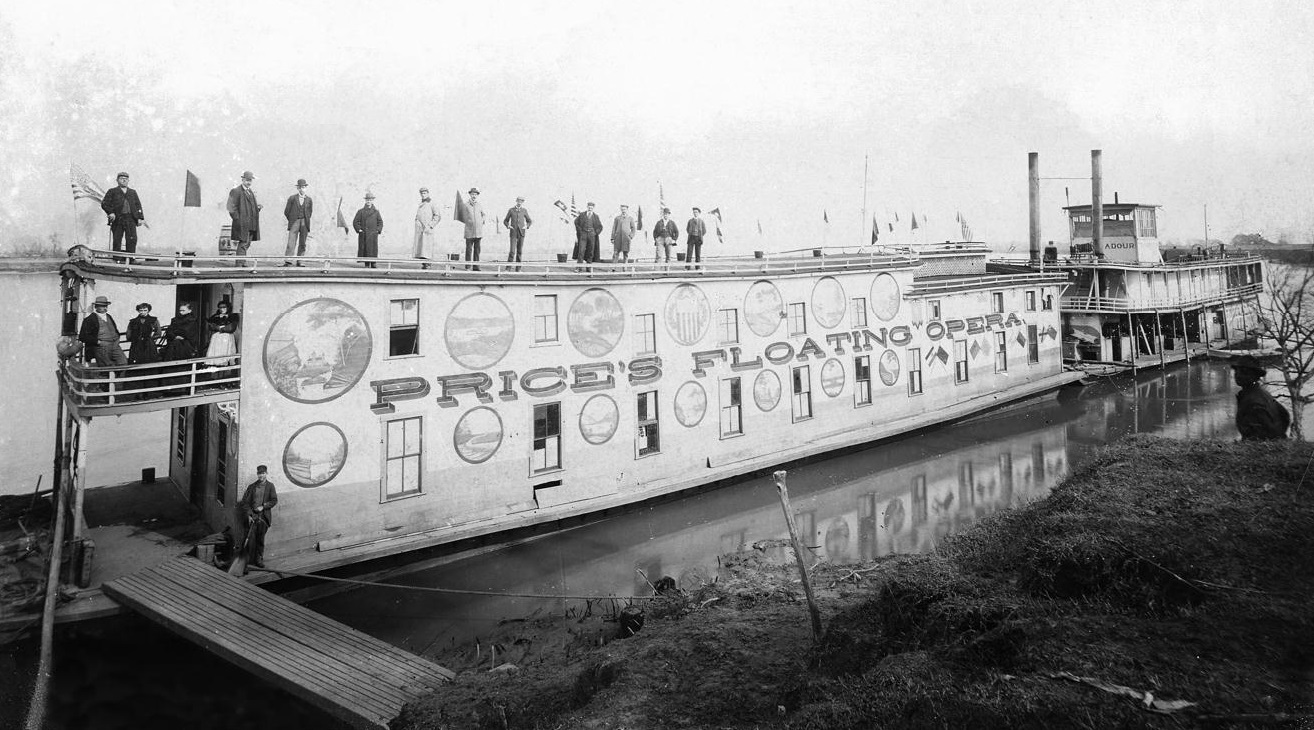
Floating Opera and Towboat Troubadour, print purchased from A. A. Miran Arts and Books. Their description below.
Card-Mounted Photo
PRICE'S FLOATING OPERA
circa 1889-1900
Showboat and Towboat Troubadour
Heavy-weight gray card with ornamental dark gray rules - measures 12.5 x 11.75" (horizontal mount). Blank back. Glossy b/w photo with sepia tones - measures 9.5 x 7.5".
This photo was remounted in the distant past. It was originally on a thin card, which was trimmed, and the card and photo remounted on a thicker card. The thicker card is quite old too, so the remounting was probably done in the early to mid 20th century. The entire photo is backed by the original card except for a small area at the extreme bottom right corner. We supplied a close-up photo of this corner so you can see that there is just a small piece of the original card chipped away there - and that the corner of the photo is intact.
This river barge ("show boat") operated from c. 1889 until it apparently sank in a storm in 1900. It was a traveling venue for entertainment, first for Eisenbarth's Combined Wild West and Opera and then Price's Floating Opera. The barge apparently had more than one tow boat in its lifetime. Here is a handsome double-decker steamer, and the the name can be made out as ADOUR - but actually the initial letters are obscured by the stacks and other elements - the tow was named Troubadour.
It is said that the entertainers lived on the tow boat and entertained on the barge. This outfit operated on the Kentucky River, the Ohio River and tributaries, and perhaps other places as well. But this barge was to our knowledge mostly often associated with the Kentucky River, and that is a likely locale for this photo. The barge was said to have been equipped with a fine steam calliope, music from which could be heard at quite a distance although here the calliope is on the top deck of the towboat.
It was also said to be gaily painted - and in the portside profile here circular illustrations appear on the showboat The scenes appear to us to be probably sights along the river. The largest one at the top left shows a large building up on a rise with two impressive turrets - historians may be able to identify it (the second-to-last image we have supplied shows this). Another circle shows what appears to us to be a canal or lock. Yet another shows a long, low vessel in a river. More could probably be told with very careful examination.
At the time of this photo, the proprietor E. A. Price apparently operated out of New Martinsville. (Note: Price had a string of bad luck. Besides losing his barge, he was also injured in a July 4, 1901 train wreck near Charleston, WV on the Kanawha and Michigan RR, where there were numerous fatalities, and newspaper accounts said he was bruised and suffered "nervous shock".)
Floating venues like this one provided welcome entertainment to people in relatively isolated areas through the 19th century and into the early 20th century - in fact Billy Bryant's showboat Princess worked the rivers into the 1930s."Show boats" had a fond place in the popular culture and imagination. This show barge was in a class with The Majestic, Captain Hart's Showboat, and others of the same general era that plied the rivers.
This view shows well over a dozen men and women on the barge, some evidently workers and some probably passengers or performers. The focus and contrast are quite good, so a surprising amount of detail can be seen with a hand lens of the people on the barge - their expressions and garments. It must have been a fairly cool day when this photograph was taken because the people have jacket and coats and there are no leaves on the tree in the right area.
Price's New Water Queen
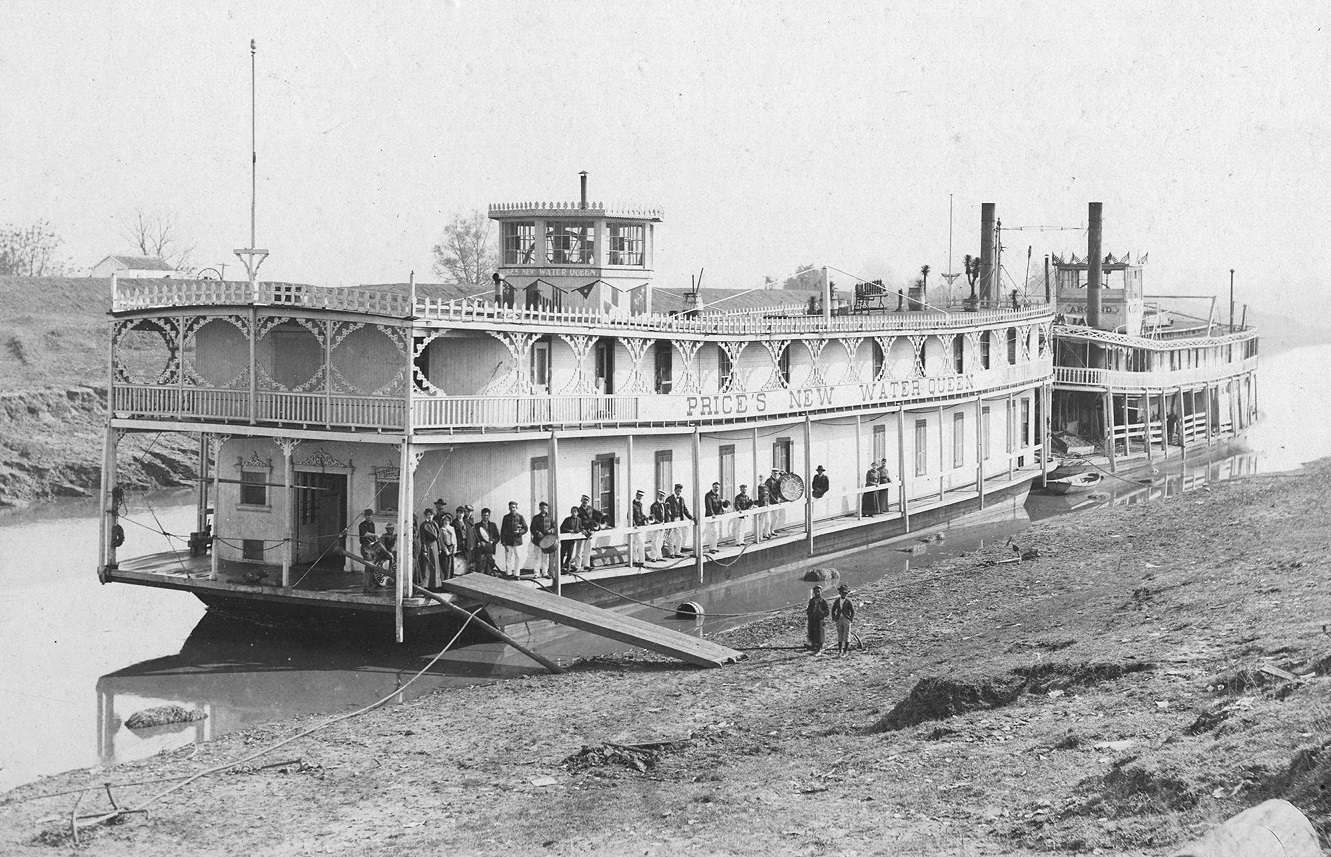
A large albumen photo of THE NEW WATER QUEEN pushed by the towboat ARGAND. It seems likely this was taken in the mile long canal near Lowell, Ohio which was constructed near the mouth of Cat's Creek to bypass a series of rapids in the Muskingum River.
WATER QUEEN
Showboat barge
Launched: 1880
Destroyed: 1915?
Area: Miss. and Oh. R.
Owner: Capt. Edwin A. Price, New Martinsville, W. Va.
Captain: Edwin A. Price
Footnote from Fred Way:
The towboat ARGAND was sold in April 1901, to Capt. Edwin A. Price, New Martinsville, West Virginia, who used her to tow his showboat WATER QUEEN. Price usually wintered in the Muskingum River at the Lowell, Ohio lock and the ARGAND burned there in December 1927. The boiler was still there in the mud as late as 1949.
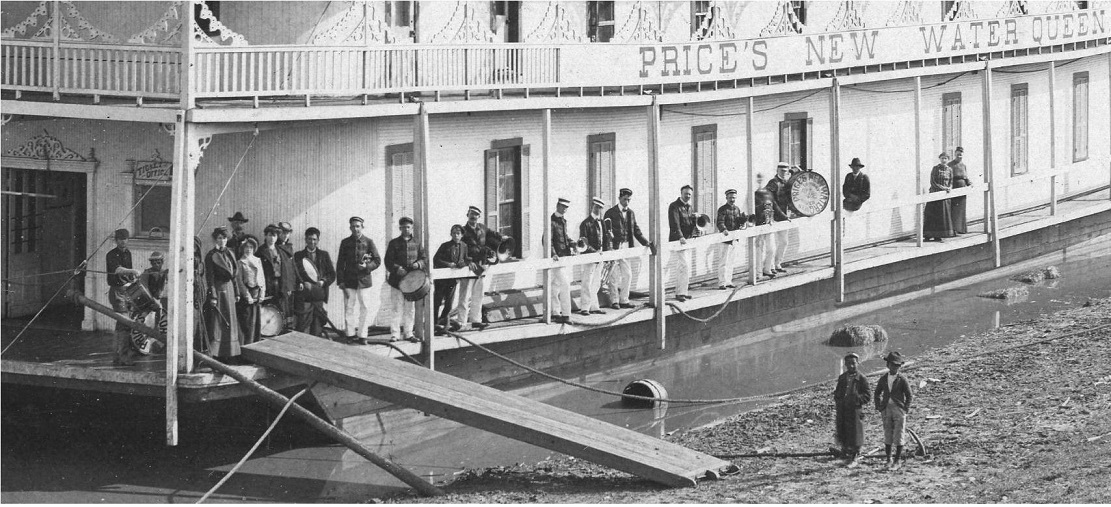
Detail of the Water Queen Showboat with actors and musicians show people. Note nice looking actresses far left. Musicians make up about a dozen aboard on deck. The two ladies far right may be back stage wardrobe ladies. Two kids on shore add a lot of charm to the picture.
FOLLOWING IS FROM THE WEST VIRGINIA CULTURE. ORG SITE ARE HIGHLIGHTS FROM A 1925 NEWSPAPER ARTICLE REGARDING THE FILMING OF A SILENT FILM STARRING GLORIA SWANSON ABOARD THE SHOW BOAT "WATER QUEEN" AT NEW MARTINSVILLE, WEST VIRGINIA ON THE OHIO RIVER. ATTACHED PHOTO OF THE "WATER QUEEN" FROM THAT ARTICLE.
Gloria Swanson and the Filming of "Stage Struck"
Wetzel Democrat
August 20, 1925
wvculture.org
New Martinsville, West Virginia
Actual filming of Gloria's great picture, "Stage Struck," was begun of Tuesday of this week with the "shooting," in the afternoon, of a number of scenes around the local wharf and on the floating theatre "Water Queen." Miss Swanson did some work on the boat during the day, and, in the evening, appeared and thanked the big crowd that was jammed in the auditorium of the "Water Queen" to furnish the "atmosphere" for the scenes that will feature Gloria's rise in the theatrical world from the position of waitress in a restaurant. There were assembled at the wharf Tuesday evening no less than 2500 persons to witness the work of the Famous Players organization, and it was a gay throng. The company had a number of powerful electric lights in operation preparatory to filming the crowd going up the stage plank of the show boat, buying tickets and going in to see the show, when the palatial excursion steamer "Washington," bearing a merry throng from New Matamaras, Sistersville and Paden City, swung into the harbor with thousands of lights of varied colors gleaming from stem to stern. Thus there were presented to view at one time the great lights used for filming, the beautiful show boat, gaily bedecked, the brilliantly lighted excursion palace and the throng of people, all of which, against the background presented by the countryside across the Ohio, made a scene that beggars description. A very amusing incident of the evening occurred when, at a signal that all was in readiness for the crowd to start on the boat, Ford Sterling, the comedian, who was in full dress and with an unusually large "stove pipe" hat, began "barking" for the show. He vociferously urged both the people on the wharf and those on the excursion steamer to attend the big show, the price of admission being only a "quawthah" of a dollar. A number of amusing scenes were also "shot" inside the boat.
The filming of many other scenes, both of individual acting and the countryside, is progressing, but it will be several days before the work is completed. Perhaps the biggest single set to be filmed will be the picnic scene in Clark's grove. It was intended to have the picnic Thursday, but postponement was necessary, and it will probably be Saturday, the 22nd. The public in general is invited.
Quite a crush of the Water Queen Tuesday night.
Scenes for "Stage Struck" were being made on the Water Queen all day on Wednesday.
Already, all the girls are wanting their hair cut just like Gloria's.
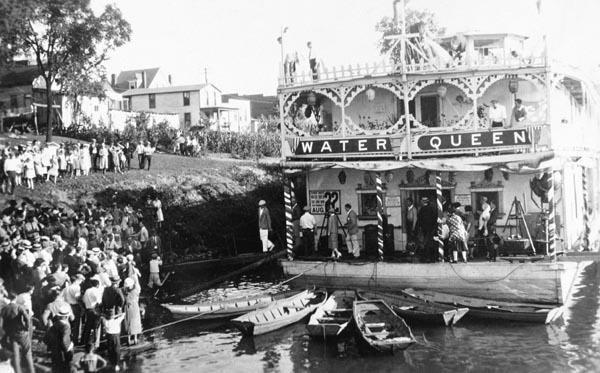
Bryant's Showboat
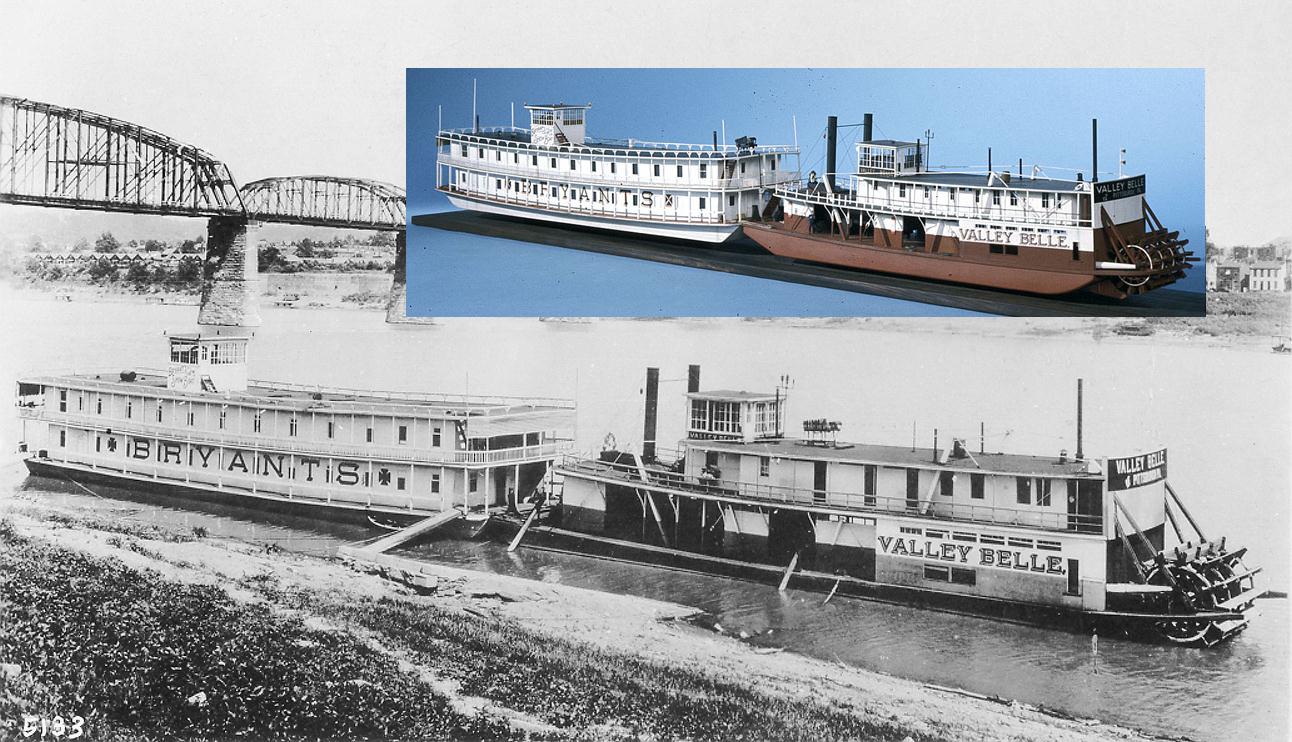
ATTACHED A COMPOSITE OF IMAGES REPRESENTING BRYANT'S SHOWBOAT PUSHED BY THE VALLEY BELLE (WHICH WE HAVE ON WAYBILLS1) I BELIEVE THAT JOHN FRYANT BUILT THE MODELS OF THE SHOWBOAT AND TOWBOAT IN THE COLOR INSERT THAT CAME FROM "AMERICAN HISTORY: ON THE WATER." BELOW A BRIEF HISTORY OF THE SHOWBOAT IS THE OBITUARY OF SHOWMAN BILLY BRYANT'S DAUGHTER BETTY FROM THE NY TIMES JANUARY 1999.
americanhistory.si.edu
BRYANT'S NEW SHOWBOAT was built at Point Pleasant, West Virginia in 1917.
Launched in 1918, it could seat around 880 people in its theater.
Most of the shows put on for Bryant's patrons in small towns along the Kanawha, Ohio, Monongahela, Illinois, and Mississippi Rivers were vaudeville or follies productions.
The ornate stage of Bryant's New Showboat was home to dozens of plays like Hamlet and Little Nell of the Ozarks, and even the antics of a trained bucking mule named January.
Owner Billy Bryant offered $10 to anyone who could stay on the animal's back, but he had to retract that offer in mining towns, as the miners were strong enough to stay on.
The vessel was sold to new owners in 1945, at the end of World War II.
Movie theaters, personal automobiles and other developments had gradually ended the colorful showboat era on America's rivers.
Betty Bryant, Showboat Performer, Dies at 76
She wrote "Here Comes the Showboat," published by the University Press of Kentucky in 1994
THE NEW YORK TIMES OBITUARY nytimes.com
By ROBERT McGILL THOMAS Jr. (1939-2000)
The New York Times, January 25, 1999
Betty Bryant, who had such a satisfying childhood career in the backwaters of show business that she never bothered to try to top herself in the Broadway mainstream, died on Jan. 15 at her home in Park Ridge, Ill. She was 76 and was recalled as the third generation of a family of showboat performers who brought corn pone and culture to riverside mid-America.
The family showboat was both her home and her stage, and for 20 years, until World War II helped bring the showboat era to an end, she spent her springs, summers and falls going from town to town along the Ohio River and its tributaries, sometimes stopping for several weeks in bigger river cities like Pittsburgh or Cincinnati.
During the off-season, with the boat tied up in West Virginia, the family would visit New York or Chicago, sometimes staging variety acts, sometimes just taking in the theatrical sights.
With her mother as her tutor, Miss Bryant managed to get her high school diploma from a cooperating school that monitored her progress.
Based on Miss Bryant's 1994 book "Here Comes the Showboat" (University Press of Kentucky), hers was an idyllic life and one she was certainly born to.
To say that show business was in her blood would be something of an understatement. Her grandfather, Sam Bryant, a onetime gardener at Buckingham Palace, had no known theatrical inclinations until he fell in love with a young Gilbert and Sullivan actress named Violet Chapman, who had inclinations enough for both of them.
After the couple married and came to the United States in 1884, it didn't take many years of nagging before Lady Violet, as she preferred to be known, had persuaded her husband to seek thespian adventure, initially, as it turned out, in a horse-drawn traveling medicine show in which Dr. Sam, as he was known, would hawk a cure-all mixture of gasoline and red pepper on the first night in a town, then stage a tent show on the second.
The couple's children, Billy and Florence, were part of the dodge from the beginning and by the time the family graduated to vaudeville a few years later, they had become the Four Bryants.
A chance summer booking on a turn-of-the-century Mississippi River showboat gave them the river bug. Within a few years, Dr. Sam and Captain Billy, as his son was soon known, had acquired first the Princess and then, in 1918, Bryant's New Showboat.
By then, Captain Billy had married the floating troupe's piano and calliope player, Josephine Costello, who gave birth to Betty four years later.
From her start in "Uncle Tom's Cabin," Miss Bryant swiftly advanced to other roles and vaudeville turns, including impressions of George M. Cohan and Eddie Cantor.
As the only member of her generation among the now six Bryants (although Aunt Florence was increasingly an absentee actress), she played boys as often as girls, but regardless of the sex, she soon learned, her forlorn character was sure to die before the final curtain.
That's because the Bryant plays tended to be heavy, heart-rending melodramas, which never failed to delight their small-town audiences.
Captain Billy did stage an abridged version of "Hamlet" once, but after he got a look at the dazed audience on its way out, he quickly reverted to more familiar fare, replacing it with "Ten Nights in a Barroom," a sure audience pleaser, partly, no doubt, because Miss Bryant died so convincingly.
By the time she graduated to grown-up roles, Miss Bryant had mastered the psychological subtleties of the showboat method of melodrama.
As she wrote in her book, "A dependable leading lady must be able to run, duck, fall, get up, fall again, crawl over a bed and under a dresser, scream, swing by a rope, deliver an uppercut, struggle and kick and still have enough breath left to say, 'If this is aristocracy, thank God I'm a country girl.' "
At 20 she married a fellow showboat actor, Jat Herod, a jazz violinist who joined the Army and was soon entertaining troops, as he and his wife continued to do after the war.
She is survived by two daughters, Jo Aleene Miranda of Des Plaines, Ill., and Mary Perry of Park Ridge, and three grandchildren.
After their divorce in 1962, Miss Bryant, who never tried to win acting jobs in New York or Hollywood, settled in Park Ridge, where she directed amateur theatrical productions and frequently gave lectures on what it was like to grow up on a showboat.
Betty's father wrote his own saga of showmanship in the floating palace venue:
CHILDREN OF OLD MAN RIVER, The Life and Times of a Show-Boat Trouper. By Billy Bryant was first published by Lee Furman Inc. in 1936, then reprinted in 1988 by Lakeside Press. Out of print book dealers offer copies of both these editions online at Abebooks and Alibris.
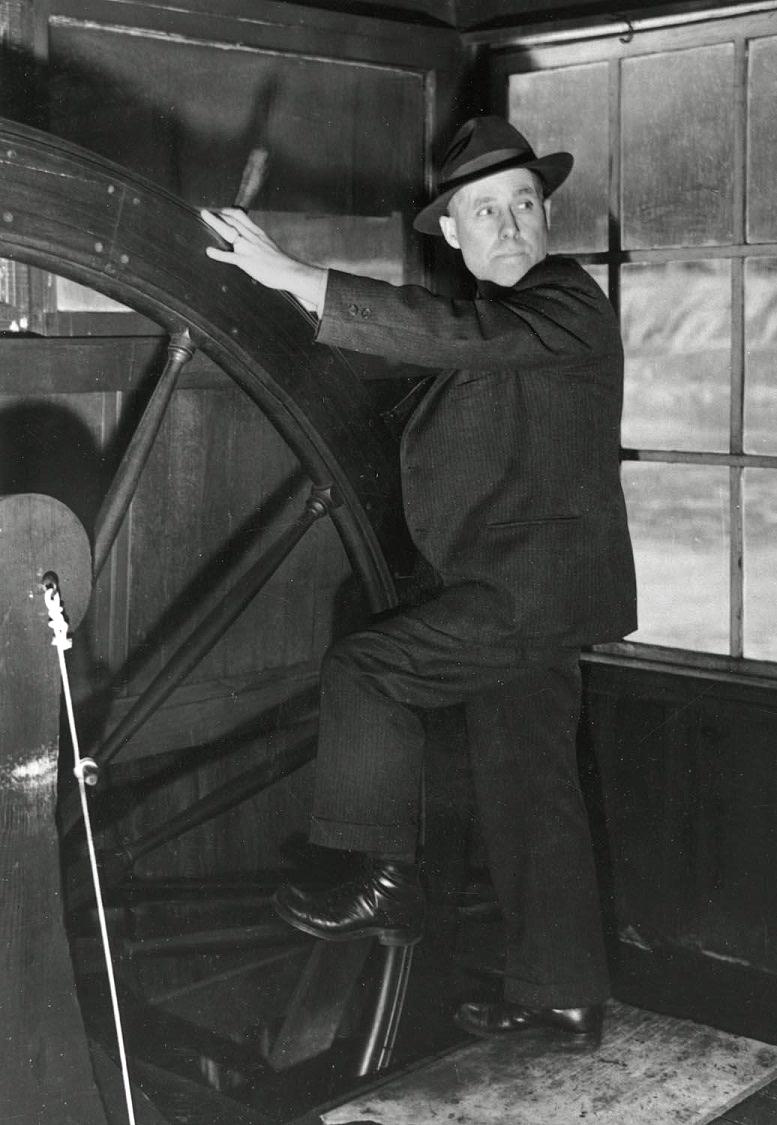
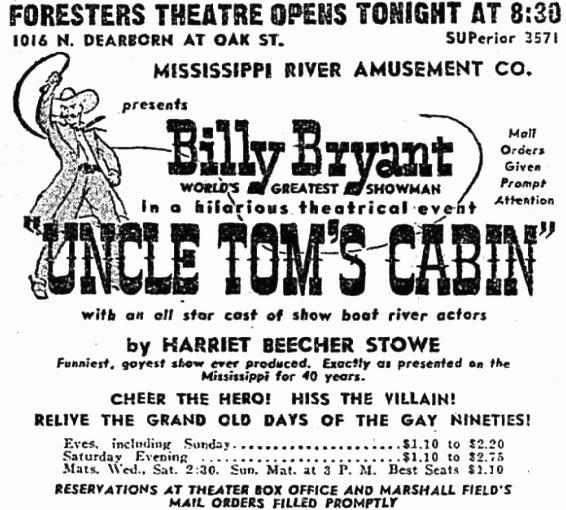
Bryant's Show Boat company in Chicago 1943 performing Uncle Tom's Cabin
I recently located this 1943 review of a Bryant show boat players show in Chicago and made a text scan of it. The photo of Billy Bryant at a pilot wheel was most likely taken aboard the towboat VALLEY BELLE which pushed his show boat from 1919 - 1939. It's a rather "film noir" style portrait of Billy in a suit and hat reminiscent of Bogart as Sam Spade in "The Maltese Falcon." The ad from the Chicago paper in 1942 for the "Mississippi River Amusement Company's" UNCLE TOM's CABIN production was in a column next to the article below. "Cheer the hero! Hiss the villain!"
Chicago TRIBUNE
23, May 1943
Showboat Actors Give 'Uncle Tom's Cabin' Tonight
Billy Bryant Presents River Cast at Foresters Theater
By Cecil Smith
Since revivals seem to be the current fashion in the legitimate theater, Messrs. Goldberg and Pfeiffer, have contributed to the city's cultural life thru their sponsorship of "Maid in the Ozarks," have dug up what may be the revival to end all revivals.
Hunting about for a corny spectacle with which to loosen a few more coins from Chicagoans' pockets, they his upon the irresistible combination of Billy Bryant, the reigning monarch of showboat acting, and Harriet Beecher Stowe's indestructible melodramatic tear-jerker, "Uncle Tom's Cabin."
Tonight at Foresters theater. which is at Oak and Dearborn streets, Capt. Bryant and his "all-star cast of river actors" will show us their way of presenting a "Tom show."
It is hardly necessary to detail the history of "Uncle Tom's Cabin" and certainly impossible to do so in encyclopedic detail.
No play ever produced in the United States has been given so many times, or in so many places.
It is the greatest hit of all time in the American theater, and even 90 years of change in public temper and dramatic technique have not eliminated it from the boards.
Three amateur productions of "Uncle Tom's Cabin" have been given in and around Chicago this very season.
There is, however, a special reason for renew interest in "Uncle Tom's Cabin" at this particular moment.
One of the outstanding, performances of the New York theater season is that of Helen Hayes in "Harriet," in which she appears as Mrs. Stowe and lives thru the events before and after the writing and publication of her great novel. Although the authors have not intended " Harriet" to present any sort of Parable, the spectacle of her unyielding idealism in difficult times is gratifying to us today, we pass thru difficult times of our own.
No other American literary work has passed more completely into the domain of folk literature than "Uncle Tom's Cabin."
This process was undoubtedly hastened from the start by the stage adaptations which were immediately made, so that Uncle Tom, Little Eva, Topsy and Simon Legree all became living, breathing people to playgoers across the length and breadth of the country.
Since it was a piece of regional, as well as universal writing, "Uncle Tom's Cabin" naturally found special favor along the Ohio River where old fashioned showboats have plied for upwards of a century, offering performances to the townsfolk along the river banks, who never saw any living theater unless it came to them by boat.
There it is that Uncle Tom, Little Eva, Top, and Simon Legree all became living, breathing people to playgoers across the length and breadth of the country. Much of the longevity of the play may be ascribed to the central character of Uncle Tom, who still commands honest sympathy even from those who snicker at the mawkish sentimentalism of Little Eva or the crude villainy of Simon Legree.
There is therefore nothing unauthentic about a showboat version of "Uncle Tom's Cabin." for Mrs. Stowe, tale has long been a staple of river repertory.
Billy Bryant was not born on the river, but he has identified himself with it since boyhood, and he now probably the most famous and most colorful Impresario among the few who still operate showboats. (At last count, there were four showboats left on the Ohio and Mississippi rivers, and one of these, at St. Louis, is hardly typical, since it is moored there the year around, and never travels from town to town in the traditional manner.
Capt. Bryant would prefer it spend this summer on his beloved Ohio River, where the citizens of Cincinnati have given him particularly loyal support. But oil rationing puts difficulties in his path, and he has thought it better to compromise with wartime obstacles by moving into Foresters' theater and performing for the city slickers. This is not a new move for him for he presented his version of Hamlet" at the Cort Theatre in 1932.
If anybody ever came up the hard way, Billy Bryant did. His father was a British gardener, and his mother belonged to the cast of an itinerant Gilbert and Sullivan company which toured the English provinces. Family opposition to their marriage caused them to migrate to the United States. For a few years they picked up a precarious living with their own medicine show, in which the elder Bryant sold a cure-all made of gasoline and cayenne pepper, while his wife and two children - Billy and Florence - entertained with their limited supply of variety songs and sketches.
When their fortunes were at the lowest ebb, after even an unsavory saloon engagement in Buffalo had petered out, they answered an advertisement in a Buffalo paper and found themselves members of the acting company on the showboat River Queen. Once the sound of the calliope and the melodious groan of the steamboat whistle had resounded in their ears, they became enchanted by the river life. Their love for the river was doubtless enhanced by the fact that their act, which had been a dismal failure in the dry land theaters and saloons, was an instant show-stopping success at the River Queen's very first of call.
Capt. Bryant has no illusions about the higher values of his own art or that of his company of "all-star river actors." His philosophy, if such it may be called, provides a revealing little character sketch: "To be a ham and not know it is a pitiful thing," he observed, "but to be a ham and know it is beautiful!"
It is significant, perhaps, that no detailed list of the personnel of Capt. Bryant's company has ever been submitted to this desk. We are asked to take the players on faith,
just as people in the river towns do, and to assume that we need no more reassurance than Capt. Bryant's promise to give a standard river performance.
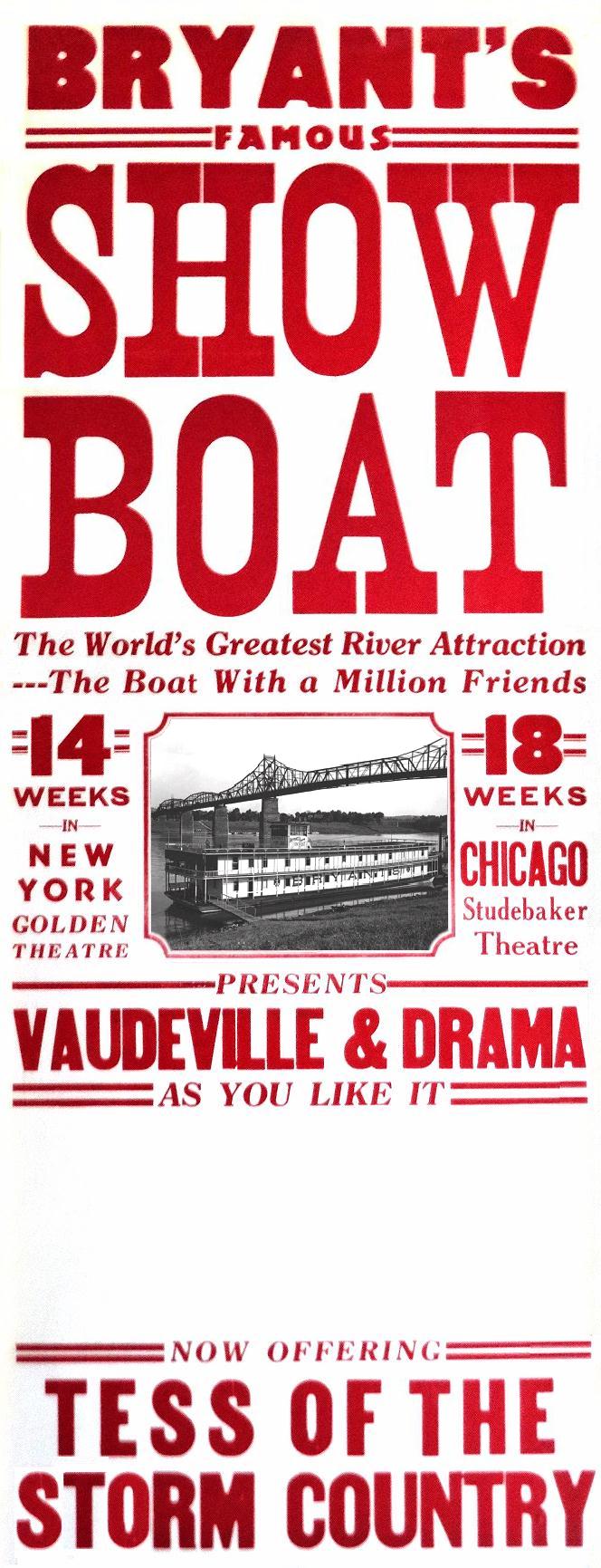
13 1/2 x 35 1/2 inch original poster for Billy Bryant's SHOW BOAT
"The World's Greatest River Attraction - - - The Boat With a Million Friends"
Includes mention of performances given by Bryant's actors of showboat "melodramas" and vaudeville acts on the legitimate stage in New York and Chicago.
Synopsis of the story that Bryant's players were going scheduled to perform:
goodereads.com
Tess of the Storm Country
by Grace Miller White
Published in 1909, this classic romance is set in Ithaca, New York. Living in a squatters shanty, shunned by the upstanding folk of Ithaca, Tessibel Skinner is nonetheless shocked when her father Orn, a fisherman, is accused of murder. Barefoot, beautiful, and innocent, Tess sets out to clear his name.
Along the way, she falls in love with Frederick, the son of wealthy neighbor Elias Graves who lives in a mansion on a hill high above the lowly squatters.
Tess lives in a rotting shanty surrounded by fish bones. Her education is minimal. Her best friend is a toad. How can she compete with the brainy beauties Frederick squires around?
Tess of the Storm Country was made into movies on four separate occasions between 1914 and 1960. The second silent film version that was filmed in 1922 starred Mary Pickford.
Goldenrod
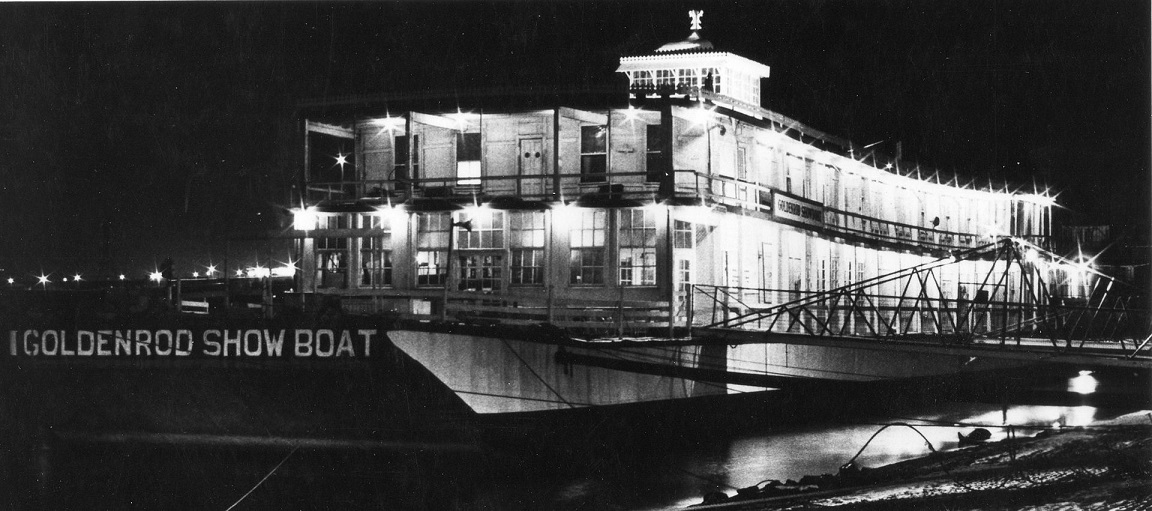
Attached night time view of the GOLDENROD show boat was taken by Wayde Scanlon in the early 1980's Scanlon's photo and the article below are both from the wikipedia article online.
Wikipedia
Goldenrod was built in 1909 by Pope Dock Company of Parkersville, West Virginia for W.R. Markle at a cost $75,000. At 200 feet long and 45 feet wide, she had an auditorium 162 feet long with twenty-one red velour upholstered boxes and a seating capacity of 1,400.
In 1910, twenty-one showboats, plied the Mississippi, visiting 15 mid-western states. (Showboats were typically non-powered barges with entertainment palaces built upon them.) By 1928, this number had dwindled to eleven, and by 1938, only five remained in operation. Between the Great Depression, movies, and increased mobility, the days of the showboat were all but over.
Goldenrod was the last showboat to work the Mississippi. Under the ownership of Capt. Bill Menke, she was moored at the St. Louis riverfront in 1937. By 1950, she had been partially sunk and salvaged twice. Shows were still being staged, and, for 75 cents a head, St. Louis playgoers could board the boat and "sass the actors" on stage.
On 1 June 1962, a disastrous fire, caused by an electrical short, all but destroyed the superstructure of the auditorium, and caused severe damage to the entire structure. The Goldenrod was then purchased by a group of St. Louis businessmen headed by Frank C. Pierson and Don Franz, and restored to her original glory, and beyond. Plush carpeting was laid in the auditorium, with cabaret seating, under a huge crystal chandelier. Many antique appointments were salvaged from old St. Louis mansions being torn down. Brass fixtures and rails were restored or replaced, as was the tin ceiling and elaborate woodwork. A cocktail lounge was added, with a small bandstand where the St. Louis Ragtimers band played traditional ragtime for many years. The upstairs staterooms were converted into a buffet dining room. When this $300,000 renovation was completed, Goldenrod had her Grand Re-Opening in May, 1965. In 1967, she was registered as a National Historic Landmark. Mr. Pierson also owned the Becky Thatcher, a former packet boat, traveling no more but moored beside Goldenrod, featuring a restaurant, lounges, and gift shop.
On the levee
Beginning in the early 1960s to about 1985, the National Ragtime Festival at St. Louis was held in June aboard Goldenrod. Many vintage jazz and ragtime bands were featured, including Turk Murphy and The Salty Dogs. From 1975 to 1984, Goldenrod was operated as a sister theater to the Heritage Square Opera House in Golden, Colorado, presenting a unique style of melodrama plus vaudeville olio, in a high energy format created by G. William Oakley of Denver, Colorado. During this same period, the National Ragtime Festivals, produced by Oakley, became an annual phenomenon on the St. Louis riverfront.
St. Charles
In 1989, Goldenrod was purchased by the city of St. Charles for $300,000 and moved to the historic Missouri River town. She was restored and renovated, costing the city about 3.5 million dollars over the next 12 years. The dinner theater continued to operate as a popular attraction. In 2001, she was run aground after Missouri River levels ran low. Goldenrod was closed due to Coast Guard structural repair requirements. The repair estimates were much higher than expected, and the City Council decided to sell her in 2002.
Sale
When no one offered to buy her, the council decided to give her away. Four groups submitted proposals, and the council chose Lewis and Clark Landing, a firm headed by John Schwarz. Goldenrod was moved to storage near the Poplar Street Bridge in downtown St. Louis. Later she was moved to Kampsville, Illinois, where she is currently (as of July 2011) moored on the Illinois River.
Schwarz' original intention was to place her in a protective basin to be constructed near her mooring location, but the plan never happened. Goldenrod was, instead, towed to a mooring spot next to the tugboat America, which was owned by Shelia Prokuski and Randy Newingham.
Uncertain future
In 2006, a civil suit was filed against Schwarz in an attempt to collect $24,000 in mooring fees owed to Prokuski. The case was supposed to have been settled, with Schwarz retaining ownership of Goldenrod while he found new mooring for the boat. Schwarz did not move the boat, and she was sold at a sheriff's auction in October 2007. Since there were no other bids on her, Prokuski bought her for $5,000.
As of 15 January 2008, the showboat's future was still uncertain. She remains moored in Calhoun County and mired in court as questions remain about the legality of the sale. The judge, Richard Greenleaf, said the proper paperwork had not been filed for the auction, so he has not signed off on the sale.
The couple want to sell Goldenrod but have to wait until the title clears. Though it has been reported they will sell the historic boat for scrap, Newingham has denied this.
Since 2010, Goldenrod has been under the care of Steve Debellis, Jacob Medford and the Historic Riverboat Preservation Association.
In 2015 the hull buckled when the vessel ended up on uneven land after river levels dropped suddenly while it was being moved to the riverbank. With insufficient funds to save the ship, the Historic Riverboat Preservation Association decided to save the pilothouse and as much of the interior furnishings as possible for incorporation into museum displays. Work on removing interior furnishings proceeded on Saturdays and Sundays from that point until March 31, 2016. On April 1, 2016, the vessel was given to the owners of the dock where she was moored. While the vessel's fate rests with dock owners, Jacob Medford believes the vessel will end up as scrap.
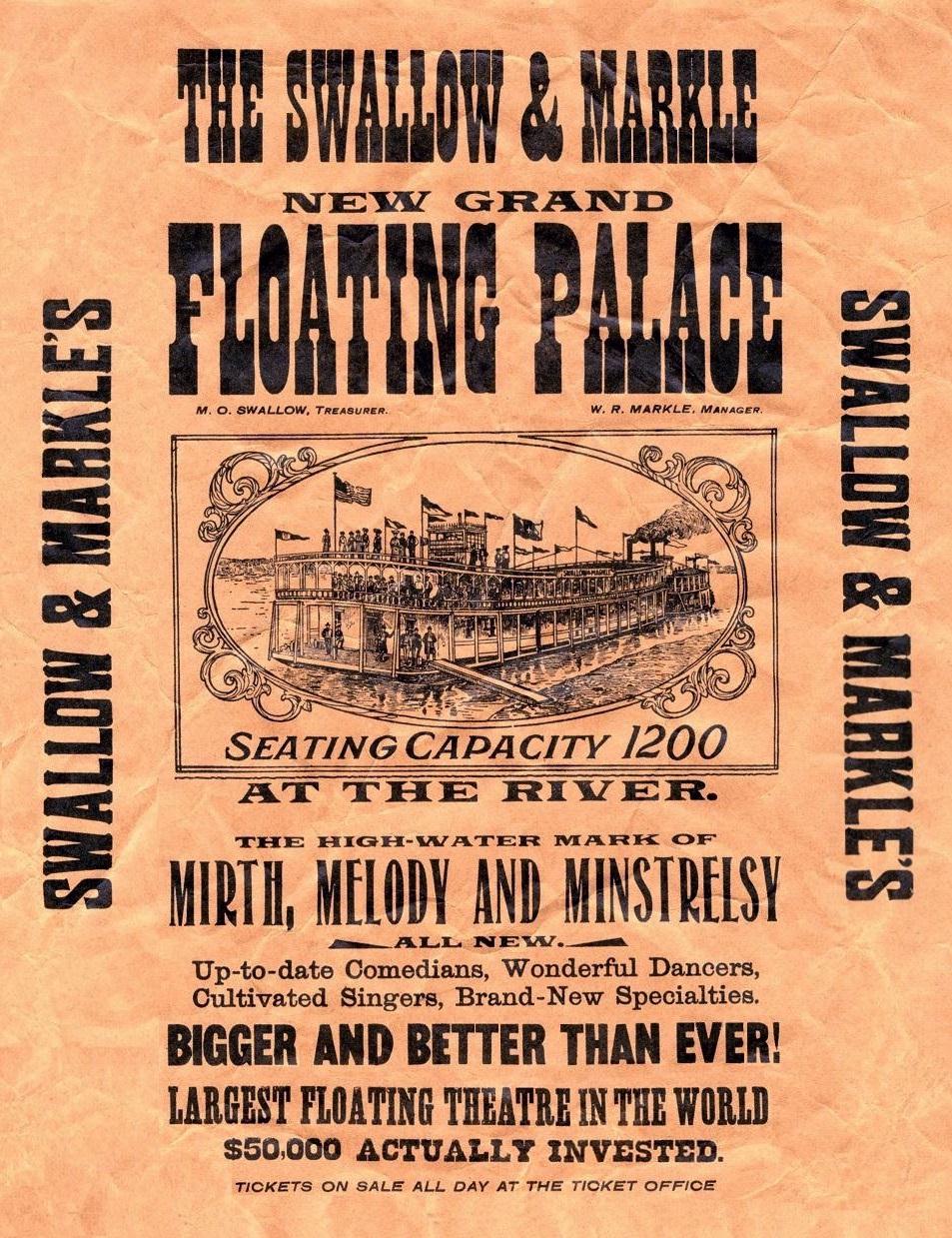
Showboat "Broadside" Swallow & Markle
This is obviously a reprint of an old Swallow & Markle Showboat broadside and it had been wadded up, then pressed flat leaving the wrinkles in an effort to make it look like an "antique." There were also a couple of provocative lines of text added at the bottom promising "Welcome Gambling Men and Unescorted Ladies" as a hint that "vice" would be available on the premises which wouldn't have been tolerated by the showboat owners. I removed the anachronistic lines which interfered with the approximation of authenticity.

With the exception of images credited to public institutions,
everything on this page is from a private collection.
Please contact Steamboats.com for permission for commercial use.*
All captions provided by Dave Thomson, Steamboats.com primary contributor and historian.
